Yellow-jackets are one of the most common wasp species and some of the most aggressive. Read on to discover more about these insects.
What is a yellow-jacket?
A yellow-jacket is a name given to Vespula and Dolichovespula wasps. As you might expect most are black and yellow, but some are also black and white. The bald-faced hornet, despite its erroneous name, is not a hornet but a Dolichovespula wasp and so a type of yellow-jacket. Outside North America yellow-jackets are simply referred to as wasps.
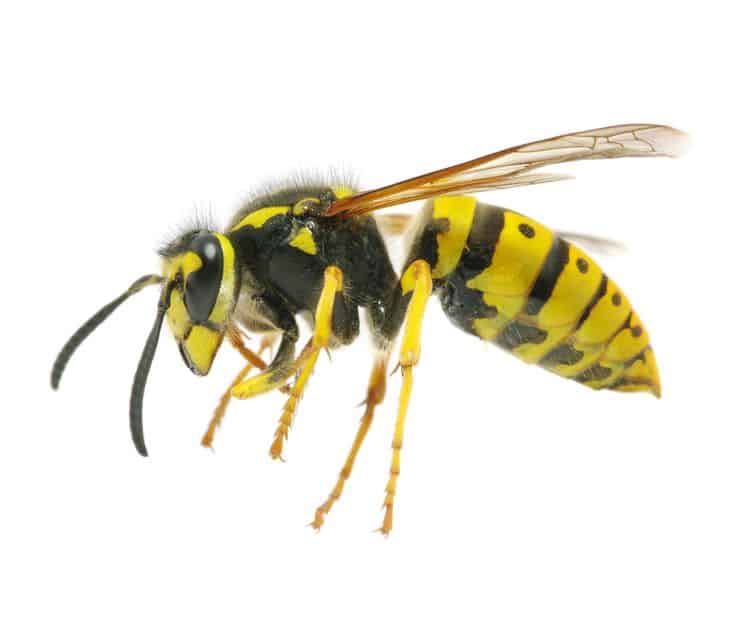
Do yellow-jackets sting?
Only the female yellow-jacket can sting. Male yellow-jackets can not sting. The stinger is part of the yellow-jacket reproductive organs, which of course male wasps do not have. Telling the difference between a male and a female yellow-jacket is very difficult, but most yellow-jackets are female. Males are far fewer as their only role is to mate with yellow-jacket queens. For this reason, they do not live more than a week or two. Male yellow-jacket wasps will still pretend to sting even though it doesn’t have a stinger as a defense mechanism. Read more about male and female wasps here.
Can yellow-jackets sting more than once?
Yellow-jacket females can sting multiple times. Unlike bees, they do not die when they sting people. They can release venom from a venom sac in several stings, although the amount of venom released in each sting does vary. Read more about wasps stinging here.
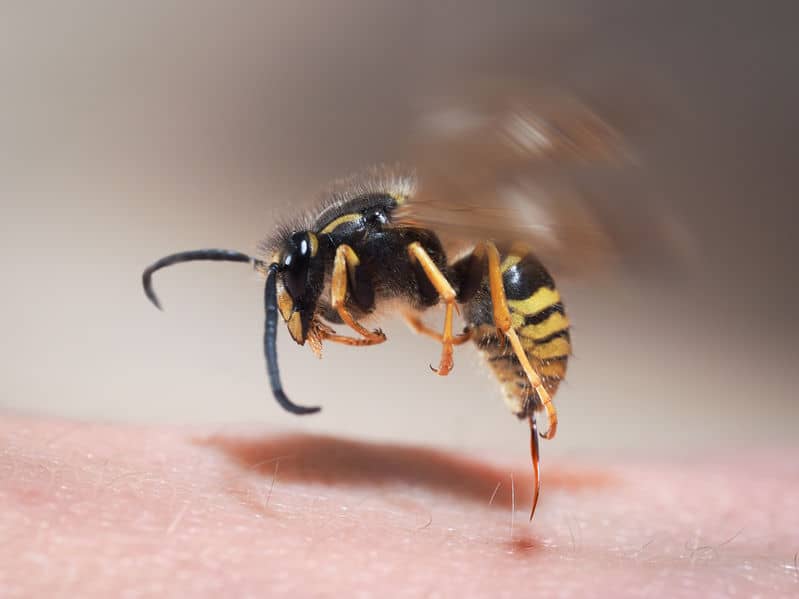
Is a yellow-jacket sting painful?
Yellow-jacket stings are painful but less so than other wasp species. On the Schmidt insect pain index, the sting of a yellow-jacket was given a score of 2 out of a maximum of 4. Schmidt described the stings as ‘Hot and smoky, almost irreverent. Imagine W.C. Fields extinguishing a cigar on your tongue.’ Read more about the Schmidt insect pain index here.
Why do yellow-jackets sting humans?
Yellow-jackets only sting humans as a form of defence. They may attack humans if they perceive their nest to be threatened or when competing over food and other resources such as water. They are noted as being more aggressive than other wasp species. Their form of defense can often be one of attack. If threatened their instinct typically is not to run away, but rather to attack. In addition, if threatened they can release a pheromone that attracts other yellow-jackets. Flapping at a yellow-jacket will likely only intensify its attack as it will feel more threatened. The safest action is to calmly remove yourself from the scene without striking at the wasp. Read more here about aggressiveness in wasps
Do yellow-jackets chase people?
Yellow-jackets will follow people when they are in defense mode. Yellow-jackets will attack as a form of defense and that means they do not back down easily once threatened. If they sense their nest is threatened they will likely persist in following the threat until the threat has moved some distance from the site. The calmer the individual is and the less they react to the wasp the more likely the wasp will cease following people.
It is also possible that a wasp will go into hunting mode and follow a food source. In this situation, if the wasp is persistent it may be worth sacrificing a part of the food to the wasp. Another option is to set up wasp traps to entice wasps and keep them away from people. See this article on wasps’ attraction to food.
Are yellow-jackets dangerous to people?
Yellow-jackets are not dangerous to most people but can pose a danger to people if many wasps attack a person at once. While painful, yellow-jacket stings are only really serious risk to be people with an allergic reaction. If suffering an allergic reaction then the situation can be very serious and immediate medical assistance should be sought. For more advice on this go here. Even for those not allergic, multiple stings of 30 or more should be treated with caution. This is rare and is only likely to happen if a nest is disturbed.
Can yellow-jackets harm cats and dogs?
Unless a dog or a cat has an allergic reaction to the sting then in most cases it will not be serious. If an animal disturbs a nest it is possible that they could suffer multiple stings. Animals tend to be very resilient and in most cases will recover quickly. Some symptoms that they might be suffering from an allergic reaction include vomitting and rapid breathing as well as excessive swelling. For more information go here.
Can yellow-jackets dig?
Yellow-jackets do not dig but do shift loose earth. Yellow-jackets that nest underground take over an existing cavity created by digging animals such as gophers and voles. Read more here.
Do yellow-jackets nest underground?
Vespula yellow-jackets typically build their nests in underground voids. Dolichovespula yellow-jackets, however, typically do not build their nests underground. Despite their name and categorization Dolichovespula wasps are identifiable by their black and white coloration. The bald-faced hornet is actually not technically a hornet at all, but rather a Dolichovespula yellow jacket. The fact that they typically build their nests above ground may explain why they gained this erroneous name.
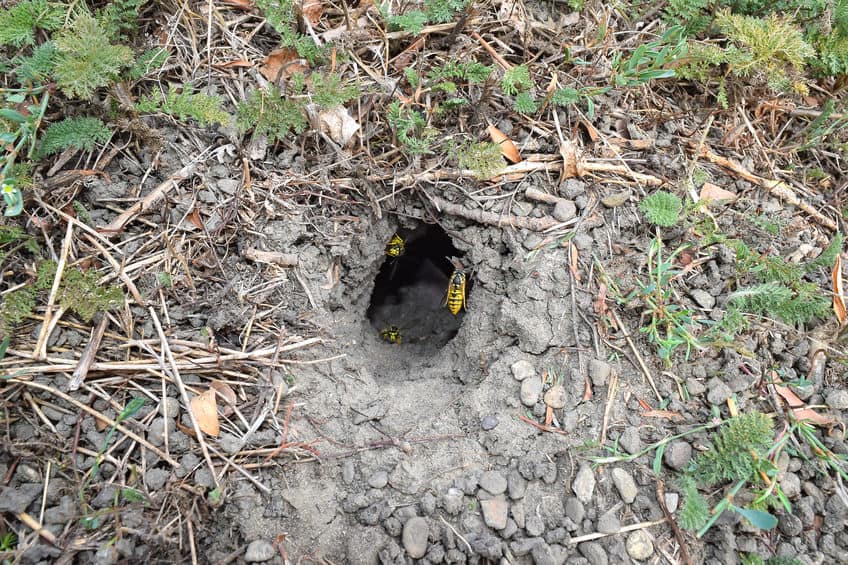
Do yellow-jackets make paper nests?
Like most social wasps yellow-jackets do make paper nests. Often they are underground so not visible, but each individual wasp larvae will sit within a section of a paper nest. The intricate honeycomb-like structure is a marvel of engineering. Paper wasps are named after their paper nests, but in fact, most social wasps produce paper nests, not only paper wasps.
Are yellow-jackets attracted to wood?
Yellow-jackets are attracted to wood as they use it to make cells in their nests. Although many yellow-jackets will make their nests underground they are still using wood to form a nest. The yellow-jackets like paper wasps will scrape wood, chew it, and then deposit it to form their intricate nests. Yellow-jackets will leave visual scrape marks on the wood. Go here to read more about wasps and wood.
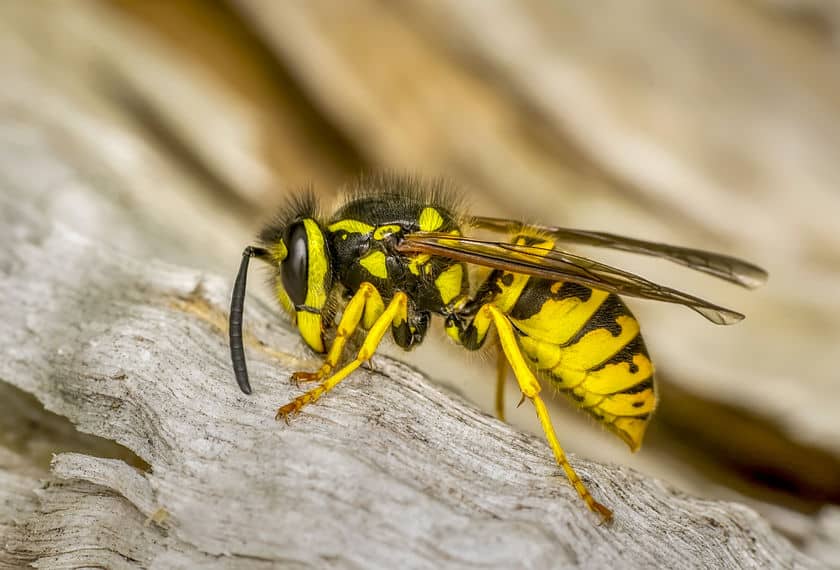
Can yellow-jackets nest in walls?
Yellow-jackets often nest in cavities in the ground, but can also choose to nest in cavities within homes. A house or outbuildings can become a site for a yellow-jacket nest. If a lot of yellow-jackets are entering your house it is a sign that there could well be a nest nearby. Check out this article.
Do yellow-jackets use old nests?
Typically yellow-jackets do not reuse old nests and will avoid areas where nests, new or old are visible. New nests will be established each year by queens emerging from hibernation. It is a tactic to install a decoy nest in order to deter yellow-jackets from choosing your home to establish a colony.
Are yellow-jackets carnivores?
Yellow-jackets are carnivores. Yellow-jacket larvae only eat meat. Fully developed yellow-jackets eat predominantly sweet liquids such as nectar and honeydew. They will most commonly prey on small insects such as caterpillars, flies, and aphids.
Although yellow-jackets are prolific hunters most of this insect prey is taken back to the larvae. They will chop up the prey with their mandibles, before chewing them and feeding this to the larvae. Fascinatingly the larvae secrete a sweet byproduct which the worker wasps then consume.
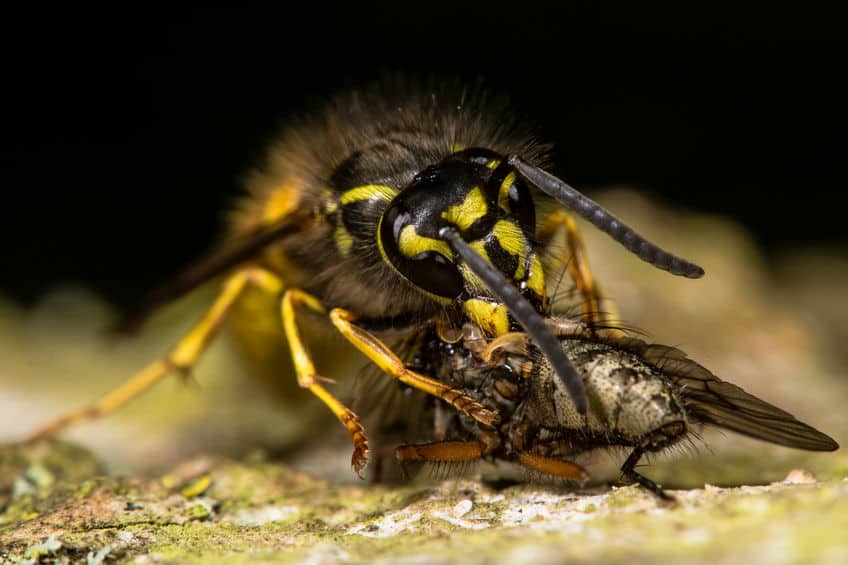
What do yellow-jackets eat?
Yellow-jackets primarily seek out sugary foods such as nectar and honeydew. They are opportunistic and will be attracted to sugary drinks and foods. Yellow-jackets can not eat solid food, although their larvae can. They consume food through are a straw-like mouthpart called a proboscis. Insect prey such as caterpillars, flies, and aphids will be fed to their larvae.
Are yellow-jackets attracted to meat?
Yellow-jackets are attracted to meat and will cut off small chunks to take back to their nests as food for the larvae. You may well see yellow-jackets on your meat if it is left outside. Yellow-jackets can also be attracted to pet food. Read more about wasps’ attraction to meat.
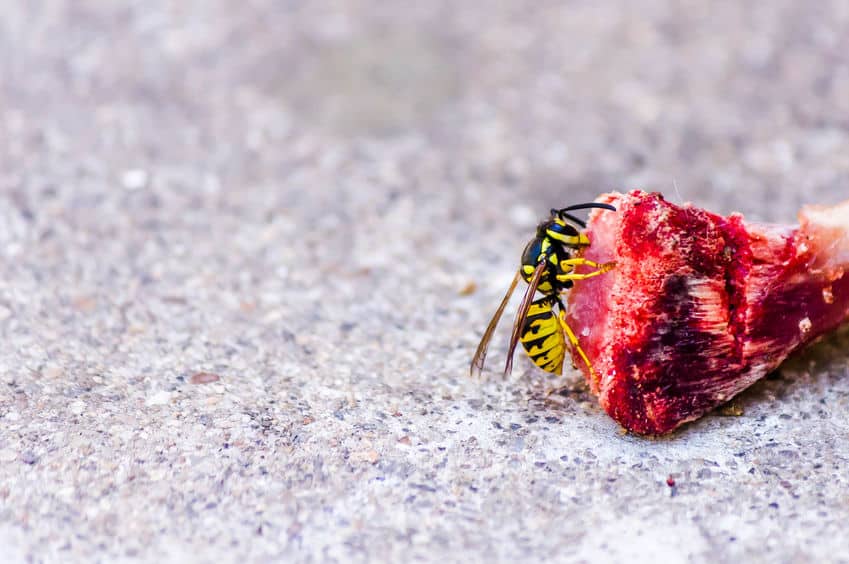
Can yellow-jackets bite?
Yellow-jackets do not have teeth, but they do have biting mouthparts known as mandibles. They are more akin to crab claws than teeth. They are used to decapitate and chop up their insect prey. These can nip people, but human skin is too thick for these mandibles to be able to penetrate to any significant degree. They will often grab onto the skin with their mandibles in order to provide a purchase for them to inflict a sting.
What eats yellow-jackets?
Yellow-jackets are eaten by skunks, weasels, raccoons, bears, various birds, spiders, and lizards. As ground nesters, yellow-jackets are targeted by mammals such as skunks that are attracted by the wasp larvae in the nest. These grubs attract many animals to this concentrated rich source of protein. Skunks and other animals will dig up the nests and consume the larvae. Bears will also target nests in shrubs for the larvae. Read more.
Do yellow-jackets pollinate?
Yellow-jackets do pollinate plants. The primary food for yellow-jackets is nectar. They will fly from flower to flower to drink the nectar and in the process, they will pollinate plants. They have less hair than bees, which makes them less efficient pollinators but nevertheless they still make a significant contribution to pollination. Read more about pollination here.
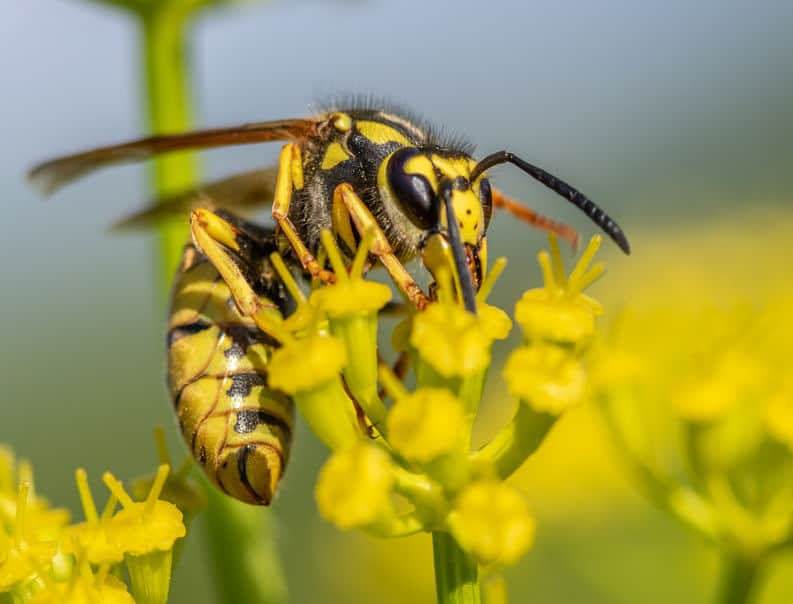
Do yellow-jackets gather pollen?
yellow-jackets do not gather pollen as they do not make honey and their larvae do not feed on pollen. Yellow-jackets are primarily interested in nectar as this gives them the sugar they crave. The yellow-jacket larvae unlike bees feed on insects, not pollen.
Are yellow-jackets good for the garden?
yellow-jackets do have benefits to the garden. They are prolific hunters and will kill many insects perceived as pests such as aphids and caterpillars. It has been estimated that a colony will consume thousands of insects over the course of a season.
Yellow-jackets will also help to pollinate plants as their primary food source is nectar, and as such, they will pollinate plants as they fly from flower to flower.
Why are yellow-jackets entering a house?
Yellow-jackets are attracted to houses for shelter, warmth, food, and water. They are opportunistic and will be attracted to a source of sweet foods and also meat. It is possible that a queen might have hibernated in a home over winter to escape the cold. Yellow-jackets can build nests in cavities within homes. Read more.
Does soapy water kill yellow-jackets?
Soapy water does kill yellow-jackets. Like other insects, yellow-jackets breathe through holes in their abdomen. These small holes get blocked by the soapy water and prevent them from breathing. Spraying soapy water can, therefore, be quite effective but caution should be taken as they will become aggressive in numbers if they feel threatened.
Are yellow-jackets repelled by peppermint?
It has been shown in studies that yellow-jackets are repelled by peppermint and spearmint essential oil. It is likely that the mint plant has developed a way to deter insects as the repellent effect seems to work with most insects. Adding peppermint oil to water and soap and spraying it can have a deterrent effect on yellow-jackets. Read more about peppermint as a repellent.
Do yellow-jackets have a queen?
Yellow-jackets do have a queen. The yellow-jacket queen may be slightly larger than the other yellow-jackets but otherwise is the same. The yellow-jacket queen is the founder of each colony and the only member of the colony to survive the winter.
Queen wasps live for about a year but will die at the end of each season. At the beginning of winter, a new queen after being inseminated will hibernate over winter and then set up a new colony. 99% of these queens do not make it through the winter, but the 1% that do will found colonies of thousands of wasps.
Once her colony is established the queen will never leave the nest again, and will become an egg-laying machine. The colony can not function without a queen and if she dies then the wasps will leave the nest. Go here for more information about queen wasps.
Can yellow-jackets survive in winter?
Yellow-jackets do not survive the winter. All the worker wasps will die at the end of the season by the onset of winter. Wasps are cold-blooded and can not survive in temperatures below 10°C. The only members of the colony to survive each winter are the new queens. After being inseminated they will find a sheltered place to hibernate for the winter. This is often in and around homes as the shelter and warmth attract them. In the spring she will come out of hibernation and establish a new colony, which will eventually have thousands of yellow jackets until the cycle starts all over again the following season.
Can yellow-jackets swim?
Yellow-jackets can not swim, but they can float. Yellow-jackets will be attracted to water sources in order to hydrate, collect water for nest production, and to cool their nests. Yellow-jackets can often be seen hovering just above water sources, although they may also momentarily land. Yellow-jackets do not want to go underwater, although they are able to survive water submersion for many hours. Read More.
Why are yellow-jackets attracted to pools?
Yellow-jackets need water for hydration, building their nests, and cooling their nests. Pools offer a ready supply of water to meet these needs. In addition to drinking, yellow-jackets will collect water and take it back to their nests. In order to move the earth, and construct their paper nests they need water to loosen soil and to form the pulp for construction. In the summer, water is also used to reduce the temperature within the nest.
Do yellow-jackets have good eyesight?
Yellow-jackets have an excellent range of vision provided by their compound eyes, but their vision is not in high definition. This means they are excellent at detecting movement from many angles, but the clarity of what they see is limited. In addition to compound eyes, they also have three simple eyes on their heads in a triangle shape. They appear as small black dots to us. These help them to detect light and dark, but as a whole yellow-jackets do not see well in the dark. Read more about eyesight in wasps.
Can yellow-jackets see at night?
Yellow-jackets have a very limited vision at night and typically will return to their nests. It is not believed that they remain inactive in the nest, however, and they will likely respond to any disturbance quickly and in numbers.
Do yellow-jackets have fur?
Yellow-jackets have a limited amount of body hair compared to other species of wasp and bee. They do have some fine hairs. As Yellow-jackets, on the whole, do not survive the winter they do not need fur for warmth. Also, as they do not collect pollen, unlike honey bees, so they do not need hair for this purpose either. The small amount of fur they do have can still collect enough pollen to help pollinate plants, although it is believed less efficiently than bees.
Are yellow-jackets a danger to bees?
Yellow-jackets will prey on bees alongside many other insects. They do not, however, especially target bees as hornets do. Yellow-jackets are more likely to pick off individual bees, rather than attack a beehive. In this regard, hornets are a greater risk to bees than yellow jackets. Read more about the risk to bees from wasps.
Do yellow-jackets make honey?
Yellow-jackets do not make honey, although they do like it and will be attracted to honey. They are opportunistic and will steal honey from bees given an opportunity and they will be attracted to honey on our tables. Read more about honey and wasps here.
Are yellow-jackets attracted to beer?
Yellow-jackets are attracted to beer as it is a sweet substance. There is evidence that they can become intoxicated on it, not unlike the intoxication effects they have when consuming rotting apples that have also begun to ferment. For this reason, beer is often used in traps as a lure to capture yellow-jackets. A well-placed beer trap near a picnic could divert them away from your food. Read more about wasps and beer here.
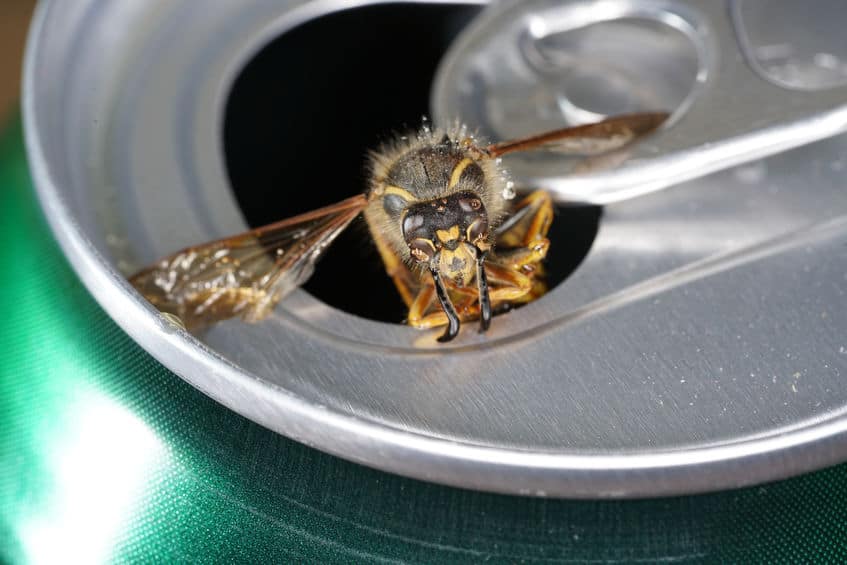
Are yellow-jackets male or female?
The vast majority of yellow-jackets are female. It is likely that you may never have seen a male yellow-jacket. That is because male yellow-jackets only exist to mate and have short life spans. They also can not sting. Only female yellow-jackets will gather food and defend the nest. Out of a colony of thousands, only a few hundred will be male.
Can yellow-jackets be pets?
It is not unknown for people to maintain a controlled colony of yellow-jackets, but due to their aggressiveness, extreme caution is advised. It is more common for people to maintain colonies of red paper wasps as they are less aggressive. In either case, a queen wasp provided the right environment and resources in the spring could effectively develop a colony within a controlled setting. It should not be attempted without thorough knowledge though. Read more about keeping wasps as pets here.
Do yellow-jackets fight each other?
Male yellow-jackets do fight each other. The males are few in number and exist for one thing only and that is to mate with queens. They will fight each other for the chance to mate and can kill each other. After mating the male wasps will die, so they have quite a short life span of only a few weeks at most.
Yellow-jackets will attack other yellow-jackets that are not from their colony. In experiments, it has been shown that they can recognize an intruder. For this reason, yellow-jacket queens will do their best to locate a nest away from other yellow-jackets to avoid conflict over territory and resources. Read More.
Can yellow-jackets recognize faces?
Studies have shown that yellow-jacket wasps can recognize each other’s faces. The faces of several wasps were painted to change their appearance and then released back to the colony. The wasps without painted faces went back untroubled, but those with painted faces were attacked by the other wasps. Clearly some form of visual recognition was taking place between the wasps. (Source: Sverdrup-Thygeson)
